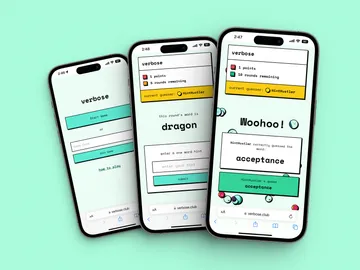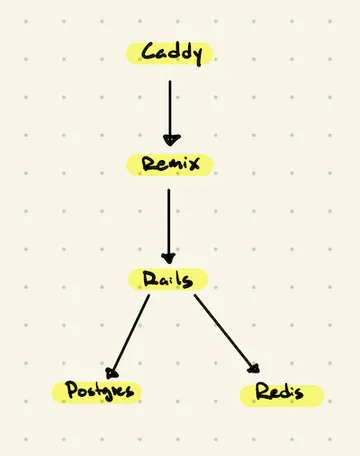What’s in a Word? Building a Verbose Party Game

Haley Johnson, Former Product Manager,
Haroon Matties, Senior Product Designer,
Andrew Thomas, Former JavaScript Developer,
Nicole Rymarz, Former Project Manager, and
David Eisinger, VP of Development
Article Categories:
Posted on
Our Pointless Palooza team designed and built a word-association game in 48 hours. Here's what we learned (and loved) while doing it.
Fun group party game. Somehow incorporate AI. Build it quickly. These were the constraints we put on our mostly Colorado-based Pointless Corp. team before Pointless Palooza. A few of us wanted to partake in the old Pointless tradition of trying out another role on the project, so simplicity was key. Thankfully, Haley was itching to build a digital version of a very fun, but relatively straightforward, game.
Just One is a collaborative word association game that encourages both teamwork and creativity. On a given turn, everyone except one player (the Guesser) knows a random mystery word and must attempt to get the Guesser to guess the mystery word via one-word hints. The catch is that every hint must be unique, so duplicate hints are eliminated and not shown to the Guesser.
Haley mentioned that she often hacked the board game to accommodate more than 7 players and thought that doing so added a fun element of chaos to the rounds. A digital version of the game would facilitate expanding the party and it seemed like an easy enough lift for our team.
It’s easier to play than explain, so mosey on over to verbose.club and give it a try. And, if you want to know more about how each of us fared going heads down on one project for 48 hours (and counting), read on.

Haley | Pointless Role: Design | Day Job: PM
My favorite part of building verbose.club was being granted permission to focus on one project with my teammates. We hopped on Meets or huddles to discuss requirements. Nicole and I jammed in the same Figma file or wireframe. I got to drop everything to QA a 600-word word bank. Viget has great ways of collaborating remotely, but it was also fun to be part of the in-office crew, having late night snacks between cram sessions like we were in college again.
Something I learned: I tried my hand at being a “designer” and learned quickly that nothing is too precious. Sometimes the code translates things differently. Also, design systems are essential to throwing together screens quickly. And Figma has tons of libraries that you can use instead of starting from scratch!
Haroon | Pointless Role: Dev | Day Job: Product Design
My favorite part of building verbose.club was stepping into a new role, or at least trying to. I got a chance to build out styled components and pages for our game with React, Typescript, and Tailwind. Though my constant questions for Andrew and David were likely annoying, it was an extremely rewarding experience to see a project come to life from another perspective.
Something I learned is that it's best to keep commits atomic, meaning contributions to the codebase are small, isolated, and clear. Though a best practice for many, this approach made it easier for me as a novice to contribute quickly, and likely made it easier for Andrew to fix things later.
Nicole | Pointless Role: Design | Day Job: PM
My favorite part of building verbose.club was seeing our team immediately dive in with a “we’re in this together” approach. I am still relatively new to Viget and it was my first time working with a handful of my teammates, so I really appreciated the collaborative environment and how everyone was really open to hearing new ideas, trying something new, and working together to make something cool.
Something I learned was how to use Whimsical and Figma to make wireframes and designs. I had used these tools before; but, it was my first time “building” anything at Viget — and it was super fun. I’m glad I got to try something outside of my usual PM role.
Andrew | Pointless Role: CEO Dev | Day Job: Dev
My favorite part of building verbose.club was coordinating work among my teammates. With less than 3 days to do everything, we had to hit the ground running. To start, our PMs and designer jumped on wireframing and design thinking while David brought to life a Rails back-end & API. I was in a good spot to act as the messenger between these two lines of work: parsing high-level thinking & decisions from the designers into information useful to David in crafting the API; then shuttling David’s feedback back to the broader team.
Next up, it was time to build out the user-facing Remix app. We were able to split this work into two parallel streams. I built out unstyled screens, game business logic, and the necessary glue code, resulting in a functional app with a barebones UI. In parallel, Haroon built out high-fidelity screens, using static placeholders where dynamic content would eventually live. From there, collaborating to merge our work and upgrade the UI was a simple task.
I think our team came out of this project inspired by what can be accomplished with smart coordination. We managed to efficiently build consensus, parallelize work, and learn from one another — and the result speaks for itself.
Something I learned was that parallelizing a project is tricky and communication is key. When multiple streams of work are progressing in parallel, decisions are constantly being made — some big, some small — and many having more influence than immediately apparent. Keeping all contributors 100% in the loop is likely impossible, and certainly unrealistic. Smart coordination and communication is the magic sauce that makes it all work.
David | Pointless Role: Dev | Day Job: Dev
My favorite part of working on verbose.club was helping from afar. I was 1,500 miles and several time zones away from most of the team, so I really focused on doing low-level work that would enable the rest of the team to be successful: setting up an API, getting the app running on Docker for easy local development, and making it straightforward for others to deploy code. It was sort of like being the bass player in a rad band.
Something I learned is that Caddy is super legit. Here’s the entire web server config file, which automatically sets up HTTPS and proxies traffic to our Remix app:
verbose.club
reverse_proxy remix-prod:3001
Our overall architecture (running with docker compose) looks like this:

In two days’ time, we had a beautiful, functioning game that we played during our Pointless celebration happy hour. Since then, we’ve added some cool animations and the ability to pull in AI players — no human friends required! So, grab some friends (robot or otherwise) and check out verbose.club!

